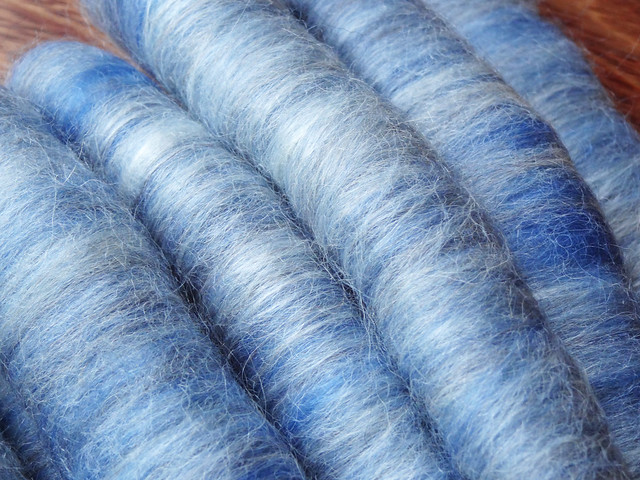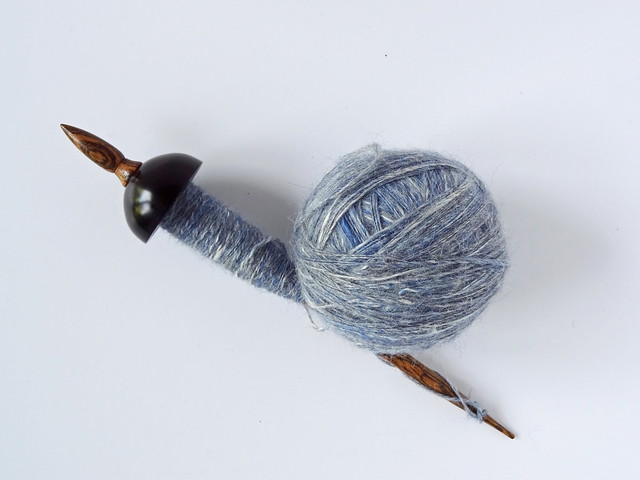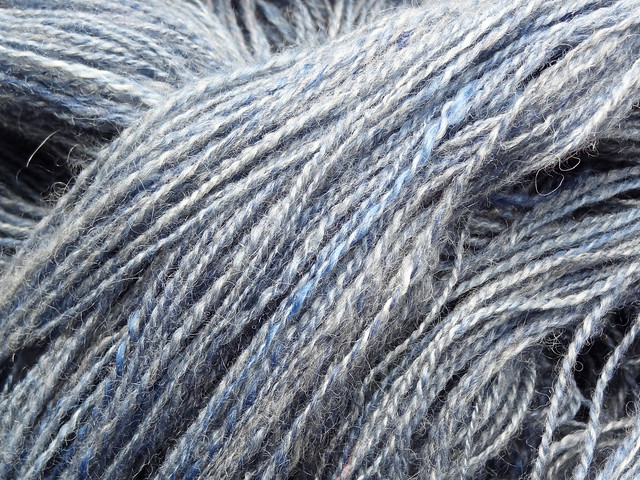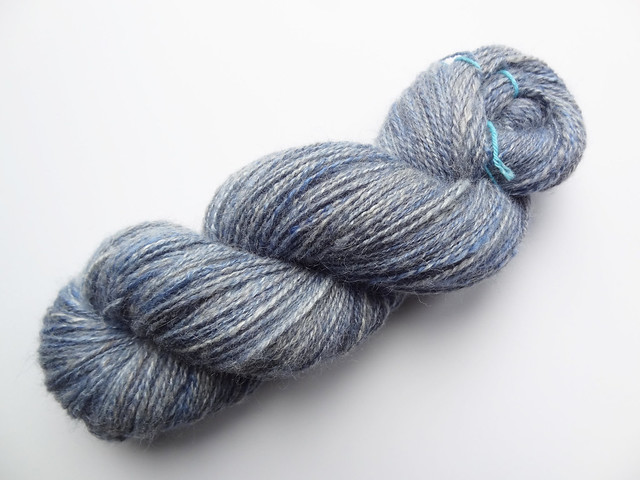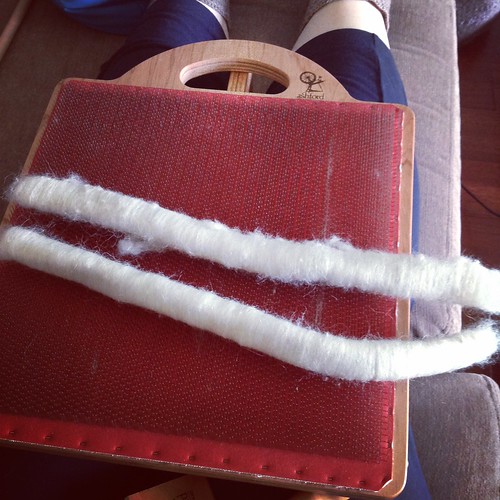In June 2013 I bought some delicious rolags from Fondant Fibre. I had never spun rolags but they were so beautiful I just had to have them. They were made of Alpaca, Bluefaced Leicester, Mohair, Shetland and Silk. They were a gorgeous pale ice blue and they called to me. If you don't know what rolags are, they are made from blending fibre on a board or on hand cards to jumble up the fibres and make them nice and airy. They are then rolled into "tubes" and they are spun from the end. This is a method of preparation that creates woollen spun yarn, if spun long draw. If they are spun worsted then the resulting will be smooth but lofty.
When I first got them, these rolags were so beautiful I was terrified of "ruining" them with my inept spinning techniques. I had yet to even attempt long draw spinning and my worsted spinning didn't seem a good fit with these rolags and I just wanted to do them justice.
Since buying these rolags I've tried spinning other sets and failed miserably and it is only in a the last month or so that I felt confident enough to try long draw on punis and felt that after a few projects I was getting the hang of it. Then came The Oldest Anything KAL being run by Emily of the Watcha Swatchin podcast and Molly of The Deepbluerenegade podcast. The idea of the KAL was to use the oldest thing that you had in a given category and to craft with it. For instance, Molly is working with her oldest Wollmeise Lace weight yarn. I immediately thought of my rolags which were definitely the oldest of my rolags and punis. It was a good motivator and pushed me into working with them.
I knew from the fibre content of these rolags that they would likely produce quite drapey yarn. I decided to emphasise that and spin a 2-ply yarn. I want to use this yarn to knit lace and 2-ply yarn is suitable for knitting lace as it pushes open the holes. I thought a fingering/4-ply weight would be appropriate for me to achieve a decent(ish) yardage from these rolags.
I used my new (and very beautiful) spindle from Enid Ashcroft. It has an ebony whorl and a bocote shaft, and the whorl is dense but narrow which gives it a nice quick spin.
Spinning these rolags was an absolute dream. They drafted almost perfectly throughout the batch and doing long draw with them was a piece of cake. I quickly got through all the rolags (112g) and I took my two individual plys and made a plying ball, which has become my default position for plying. It really does make everything easier!
I think I may have under-plied this. I have recently watched The Gentle Art of Plying with Judith MacKenzie. I bought the digital download in a recent sale on the Interweave Online Store and wished I'd watched it sooner. She explained that with a woolen spun yarn, the integrity of the yarn is created by plying. You need to add more twist that you would for a worsted spun yarn. The appearance of my finished yarn is pretty good though, so I'm really not sure what to do for the best.
What do you think? I can see it is a bit loose in places and could have done with a few more twists per inch in those areas. The finished yarn is very bouncy and soft and I didn't want to ply too tightly and make the yarn rigid. Would you ply it again and add more twist to the looser sections, or do you think it will be fine as it is?
The yarn has a lovely halo which is probably created both by the style of spinning, and the mohair and alpaca parts of the blend.
I am so pleased I waited until I comfortable with long draw before tackling these rolags because they absolutely needed to be spun woollen. I achieved a fingering/4-ply weight yarn and got 348 m/380 yds with this spin. I am pretty sure it will be a gorgeous lacy shawl or cowl.
It's just as well I'm happy spinning rolags now, because I got a blending board for my birthday last week. I made my first rolags yesterday. I think I have a way to go before I can even attempt to create something as pretty as these ones, but they are a fun way to spin and I am looking forward to making more.
If you have tried making rolags on a blending board I'd be really grateful for any tips or hints, and links to good tutorials if you know some. I've discovered it's quite physical, but if I'm careful I can get away with just using my arms and shoulders to do the work and can avoid using my stomach completely. This is exactly what I hoped for, but I will have to be very careful not to overdo it and I am going to have to force myself to only do a few rolags at a time. Still, despite my limitations, it's exciting to have this brand new tool and start finding a way to use it to create my own blends.

